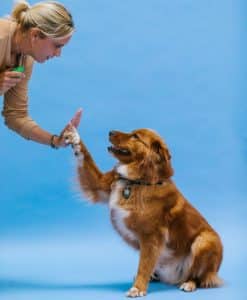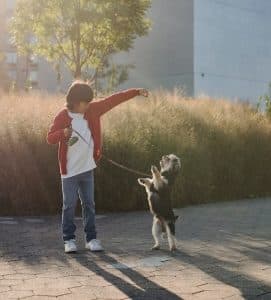
Last Updated on 2 years by Jenny Sovann
Want to know about some tips to train your dog simple commands faster? Do you know about that electrifying feeling when your dog finally shows interest in you? With its head tilted to the side, you are now sure that he is engaged with all the attention on you and probably nudging you to keep talking. You put on your professional trainer’s face, and utter the commands word by word, looking at your dog hopefully. Minutes later, you sit, sulking. You tried teaching your dog a new trick, only to end up barking in a dialect your dog did not know.
Don’t be fainthearted– you still have the ability to learn to convey messages to your dog. From the common sit, stay, stop, and rollover, we will delve deep into the cold waters of teaching your dog to understand simple commands. Let’s turn you into the dog whisperer so that all dogs will crown their supreme ruler. With that said, Let’s unleash your potential with the tips to train your dog’s simple commands faster.
Understanding Basic Dog Training Techniques
You must crawl before walking. When training dogs, you can’t just jump into advanced techniques. The first and most important step is to understand the basics. Remember that dogs learn through association. This basically means that they connect behaviors with outcomes. If you tell your dog “sit” and follow up the word with a treat if the dog actually sits, they will associate the word with a reward.
This is what we call positive reinforcement. Basically, you reward your dog for good behavior with treats, toys, or praise. It is important to avoid punishment-based training, as this can create fear in your dog, leading to an unproductive training session.
Starting with simple commands like “sit”, “stay”, “come” and “stop” will form the basis for advanced training. You should remember that the process to train your dog simple commands should be a positive experience for both you and your canine companion. If your sessions are uncomfortable, it would be better to postpone them to a day or time you both feel comfortable.
Consistency And Repetition In Dog Training
 Have you ever tried learning a new language? Yes, you don’t learn it in seconds. It takes time, consistency, and a lot of repetition. In the same way, don’t expect to dump your entire language on your poor canine friend all at once. In what way do you be consistent and repetitive? , you may ask.
Have you ever tried learning a new language? Yes, you don’t learn it in seconds. It takes time, consistency, and a lot of repetition. In the same way, don’t expect to dump your entire language on your poor canine friend all at once. In what way do you be consistent and repetitive? , you may ask.
Well, use the same command every time your dog performs a specific behavior. We don’t have to explain what will happen if you use the same command with different behaviors, do we? Your furry friend wouldn’t be able to associate the word with a behavior in the end if you choose to do this.
You have to repeat the training sessions regularly in order to enforce this behavior. If you really want to train your dog simple commands, you must know that dogs learn through repetition. The more you practice your commands with your dog, the faster that your dog will learn these commands.
Using Treats And Rewards To Train Your Dog
We probably touched on this but didn’t really mention how important it really is or how to go about it. You have to understand that dogs are foodies at heart. They will gobble everything down from scraps to dried chewy bones. They will always wag their tails in excitement while expecting their next meal from their owner. You have to use your fancy palates to drive down some commands to make your interaction with your dog much easier.
 You do remember positive reinforcement, don’t you? Well, that’s an important part of the process. You have to gradually decrease the resilience on treats though. The whole point is training your dog and having to feed him each time you tell him something will just end up being tiring and unproductive. It may seem okay, but over time it may turn out to be an expensive expenditure on treats to bribe your dog to behave.
You do remember positive reinforcement, don’t you? Well, that’s an important part of the process. You have to gradually decrease the resilience on treats though. The whole point is training your dog and having to feed him each time you tell him something will just end up being tiring and unproductive. It may seem okay, but over time it may turn out to be an expensive expenditure on treats to bribe your dog to behave.
While gradually reducing the treats, try associating the behavior with verbal cues. You will be substituting the food part with some praises, like “good boy” or “good girl”. It is important to use these cues while also giving your dog treats. This will make the dog make a connection between behavior and the rewards you offer it.
Training Tips For Specific Dog Breeds
Knowing the general behavioral traits of the breeds in question is a good place to start. Different breeds vary in their temperaments and personalities. Understanding this will ensure that your training sessions are more effective and productive. It is good to note that despite the breed, individual dogs also have different personalities.
It is important to tailor training-specific needs to your dog. Highly energetic dog breeds like huskies and border collies may need plenty of exercise and stimulation in addition to obedience training. You have to go a little easy on our little friends like poodles that just want to relax around your presence.
Some breeds are also known to be stubborn. They may show more independence and less eagerness to learn from you. Others may show tendencies towards barking or digging. You may have to be gentle or a little bit stubborn yourself depending on the various emotions your furry friends dump on you.
Overall, praising and using treats is the magic potion that will, for certain, help you modify this behavior to suit your lifestyle. Understanding of your furry friends’ specific breed traits and behaviors will build a stronger bond between you and your dog.
Troubleshooting Common Training Issues
Training dogs is a challenge, and sometimes you may never seem to get it right. You may have the best intentions but your canine companion is just having trouble learning your commands. First of all, you can try making your training sessions shorter. Break down your routine into smaller steps while always using positive reinforcement.
Sometimes these issues may be overwhelming. Disobedience by the dog. Anxiety and boredom from both you and your dog. If nothing helps so far, getting a professional dog trainer will go a long way to make life easier for both you and your furry friend. Professional dog trainers can offer the best advice on how to react to some of your dogs’ unbearable behaviors during training.
Frequently Asked Questions
Q: What is the fastest and easiest way to train a dog?
A: Every single dog is unique, making their response different to training methods different. There is no single fast and easy way. However, positive reinforcement is a sure way to make your dog well-trained and it is something you can easily do.
Q: What are the 7 basic commands for dogs?
A: Commands used on dogs are: sit, stay, come, leave, off, heel, and no. The commands vary with language and don’t necessarily have to be this. Though commands also depend on how the dogs are trained, however, these are the most used commands.
Q: How long does it take to train your dog simple commands?
A: The time taken to train a dog varies depending on the dog’s breed, age, temperament and the amount of consistency used. Most dogs learn basic commands within a few weeks to a few months.
Q: What are the 5 golden rules of dog training?
A: To train a dog you should be consistent, use positive reinforcement, consistency, and repetition, be patient, and make the sessions fun. Following these principles will improve your chances of making your dog obey your commands.
Q: At what age are dogs easiest to train?
A: Dogs are easier to train when they are younger. As puppies between 8 and 16 weeks of age, the younglings are more receptive to learning and socialization. This makes it easier to convey your commands since they are curious and eager to learn.
Q: What words do dogs understand?
A: With some basic training, dogs can quickly learn simple commands of words and phrases like “sit”, “stay” and “stop”. They can figure out the names of people, objects, and places. Incredibly they can also pick up the tone of our voices and our body language to understand our communication.
Q: What is the easiest thing to teach a dog?
A: Sit. It is a simple and natural behavior for dogs and serves as a great foundation for more advanced training. Teaching a dog to sit will also stop behavior issues such as jumping up on people.
Conclusion
To train your dog simple commands faster may seem a little hard, but following the above guide would make it a little easier. Getting a professional trainer to work their magic may help to speed things up, making it go smoothly. If you manage to crack this puzzle though, you would have figured out the importance of positive reinforcement, consistency, and patience.
Getting these key points through will ensure that you are able to convey your message to your furry friend. Ensuring that your dog is not anxious, will make the training session a whole lot more productive. The sessions should be comfortable and fun. Having sessions that aren’t fun will only result in failed attempts at training your dog. A well-trained dog after all will always make you at peace.



